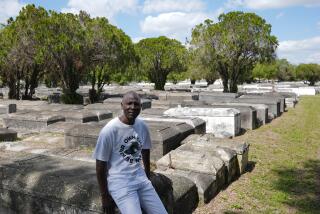National African American museum acquires casket of Emmett Till
- Share via
WASHINGTON — The Smithsonian’s National Museum of African American History and Culture has acquired the original casket of Emmett Till, whose brutal murder in 1955 energized the modern civil rights movement.
The official announcement of the donation, made by the Till family to the Smithsonian Institution, will be made today, the 54th anniversary of his death, during a memorial service in Chicago, museum officials confirmed.
What some might consider a horrific artifact would seem to be a necessary addition to the sweeping story of black triumphs and tragedies that the museum plans to tell when it opens on the National Mall in 2015.
But Lonnie G. Bunch, the museum’s director, said Wednesday he had much to consider before saying yes to the acquisition.
“The family wanted to preserve it in a respectful way,” Bunch said. “But it did raise philosophical, ethical and sensational issues that I wanted to think about. And I wanted to consider them as a museum director, as a historian, and someone who has to raise funds. I wanted to understand all the hurdles.”
Almost every museum wants an artifact that stops the visitor. The item can make you pray, shudder, cry, think. The United States Holocaust Memorial Museum in Washington has several, including a railroad car that transported Jews to concentration camps and piles of shoes worn by victims. In a tiny civil rights museum in Savannah, Ga., a partly burned cross is on display.
Bunch had no doubts about the casket’s significance. “The story of Emmett Till is one of the most important of the last half of the 20th century. And an important element was the casket,” he says.
Till, who was born in Chicago, was a 14-year-old visiting relatives outside the hamlet of Money, Miss., when he was accused of “wolf whistling” at a white woman in a grocery store. A few nights later, the woman’s husband and his half-brother pulled Till from a bed in his great-uncle’s cabin. His corpse, with a 75-pound cotton gin fan tied to his neck and a bullet hole through his head, was found in the Tallahatchie River by fishermen.
His mother, Mamie, recognized him only through the shape of his ears and the signet ring of his late father, Louis, with the initials L.T. Gone was the smiling, round face with the sparkling dark eyes. He was beaten so badly that his brain had to be removed prior to burial.
At that moment, Mamie Till made what Bunch describes as a courageous decision. She decided that everyone, and she meant the world, needed to see what had been done to her son. She ordered that the casket be open at his memorial service in Chicago. About 50,000 people filed through the church.
Then, Bunch says, another extraordinary event occurred. Jet magazine printed a photograph of Till in the casket.
“There were probably hundreds of black men who disappeared or were murdered in the 1940s and 1950s. But her demand for an open casket forced America to come to terms with this. I think it sent a jolt through America. It was not another black man murdered, but a 14-year-old boy from Chicago,” Bunch said.
The casket rested in Chicago’s Burr Oak Cemetery until 2005, when it was dug up for the first-ever autopsy. The body was transferred to another casket and reburied in Burr Oak.
The original casket also was held at the cemetery. This summer when workers at the cemetery were accused of digging up graves of approximately 300 people and selling the plots, the police found Till’s casket in a storage shed.
“Everybody was surprised that the casket was neglected. And the family and others began to ask, ‘Is there a role the museum can play?’ ” Bunch said.
Bunch hasn’t decided how to display the casket, but he knows that some will find it upsetting. “It is an object that allows us to tell the story, to feel the pain and understand loss,” he said. “I want people to feel like I did. I want people to feel the complexity of emotions.”
More to Read
Sign up for Essential California
The most important California stories and recommendations in your inbox every morning.
You may occasionally receive promotional content from the Los Angeles Times.













